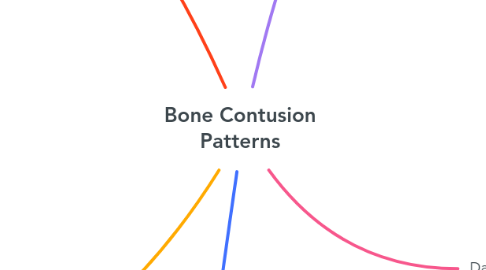
1. Lateral Patellar Dislocation
1.1. why?
1.1.1. twisting the knee whilst its in flexion
1.2. what happens
1.2.1. femur rotates internally on fixed tibia
1.2.2. contraction of quads
1.2.2.1. lateral dislocation of patella
1.3. imaging
1.3.1. contusions of
1.3.1.1. anterolateral aspect of lateral femoral condyle
1.3.1.2. inferomedial aspect of patella
1.4. other injuries
1.4.1. avulsed medial patellofemoral ligament
1.4.1.1. most important stabilising ligament
1.4.1.2. may require surgery if damaged
2. Pivot Shift
2.1. why?
2.1.1. valgus load to a flexed knee with
2.1.1.1. external rotation of the tibia
2.1.1.2. or internal rotation of the femur
2.2. what happens
2.2.1. load ACL
2.2.1.1. ACL rupture
2.2.1.1.1. anterior subluxation of the tibia relative to femur
2.3. imaging
2.3.1. ACL rupture
2.3.1.1. best seen on oblique sagittal
2.3.1.2. where?
2.3.1.2.1. midsubstance
2.3.2. posterolateral margin of lateral tibial plateau
2.3.3. midportion of the lateral femoral condyle
2.3.3.1. near condylopatellar sulcus
2.4. other injuries
2.4.1. posterior capsule
2.4.2. arcuate ligament
2.4.3. posterior horn of lateral/medial meniscus
2.4.4. medial collateral ligament
3. Dashboard Injury
3.1. why?
3.1.1. force applied to anterior aspect of proximal tibia in a flexed knee
3.2. what happens
3.2.1. impaction
3.2.1.1. anterior aspect of tibia
3.2.1.2. posterior surface of patella
3.3. imaging
3.3.1. oedema in
3.3.1.1. ant aspect of tibia
3.3.1.2. posterior surface of patella
3.4. other injuries
3.4.1. PCL
3.4.1.1. tear at midsubstance (at the genu)
3.4.2. posterior joint capsule
3.4.3. severe cases
3.4.3.1. injury to the hip
4. Clip Injury
4.1. why?
4.1.1. pure valgus stress on mildy flexed knee
4.2. what happens
4.2.1. direct blow to
4.2.1.1. lateral femoral condyle
4.2.2. avulsed MCL
4.2.2.1. medial femoral condyle contusion
4.3. imaging
4.3.1. MCL tear
4.3.2. oedema in
4.3.2.1. lat fem condyle
4.3.2.2. medial fem condyle (lesser degree)
4.4. assoc injuries
4.4.1. risk increases with increasingly flexed knee
4.4.1.1. ACL rupture
4.4.1.2. medial meniscus rupture
4.4.1.3. O' Donaoghue triad
4.4.1.3.1. mcl, acl, medial meniscus
5. Hyperextension Injury
5.1. why?
5.1.1. direct force to anterior tibia, whilst foot is planted
5.2. what happens?
5.2.1. impaction of
5.2.1.1. anterior aspect of tibial plateau
5.2.1.2. anterior aspect of femoral condyle
5.2.2. if valgus force is also applied
5.2.2.1. medial impaction noted
5.3. imaging
5.3.1. oedema in
5.3.1.1. ant aspect tib plat
5.3.1.2. ant aspect fem condyle
5.4. associated injuries
5.4.1. ACL/PCL rupture
5.4.2. meniscal injury
5.4.3. if substantial
5.4.3.1. knee dislocation
5.4.3.2. gastrocnemius injury
5.4.3.3. popliteal neurovascular injury
